Effects of Fiber and Copper Particles on Conductivity and Breakdown Characteristics of Natural Ester and Mineral Oil under DC Voltage
Abstract
:1. Introduction
2. Experiments
3. Experimental Results and Analysis
3.1. Movement and Accumulation Characteristics of Particles in Mineral oil and Natural Ester
3.2. Motion Trajectory Simulation of Particles in Mineral oil and Natural Ester
3.3. The Influence of Particles on the Current Density of Mineral Oil and Natural Ester
3.4. Influence of Particles on the DC Breakdown Voltage of Mineral Oil and Natural Ester
4. Conclusions
Author Contributions
Acknowledgments
Conflicts of Interest
References
- Huang, D.L.; Li, J.; Zhang, J.; Zhang, X.M.; Liang, S.N.; Li, X.D. Metallic particle effect on the AC breakdown strengths of vegetable insulating oil. In Proceedings of the 2015 IEEE Electrical Insulation and Dielectric Phenomena, Ann Arbor, MI, USA, 18–21 October 2015; pp. 605–608. [Google Scholar]
- Liao, R.J.; Liang, S.W.; Yang, L.J.; Hao, J.; Li, J. Comparison of ageing results for transformer oil-paper insulation subjected to thermal ageing in mineral oil and ageing in retardant oil. IEEE Trans. Dielectr. Electr. Insul. 2012, 19, 225–232. [Google Scholar] [CrossRef]
- Sun, C.X.; Li, J.; Li, X.H.; Grzybowski, S. Electric Properties of Vegetable Oil-Based Dielectric Liquid and Lifetime Estimation of the Oil-Paper Insulation. In Proceedings of the 2015 IEEE Electrical Insulation and Dielectric Phenomena, Kansas City, MO, USA, 15–18 October 2006; pp. 680–683. [Google Scholar]
- Vasconcellos, V.; Sbravati, A.; Zanetta, L.C.; Rapp, K.; Lombini, L.; Nazzari, S.; Scatiggio, F.; Valant, A. Increased loadability of transformers using natural ester and cellulosic materials as high temperature insulation systems. IEEE Electr. Insul. Mag. 2018, 34, 8–17. [Google Scholar] [CrossRef]
- Cai, S.W.; Chen, C.; Li, H.; Shao, M.F.; Chen, J.B.; Yin, J.; Guo, H.H. Research on electrical properties of natural ester-paper insulation after accelerated thermal aging. In Proceedings of the 2017 1st International Conference on Electrical Materials and Power Equipment, Xian, China, 14–17 May 2017; pp. 397–401. [Google Scholar]
- China Electric Power Enterprise Association. Natural ester transformer technology [M]; China Electric Power Press: Beijing, China, 2018. [Google Scholar]
- IEEE Guide for Acceptance and Maintenance of Natural Ester Fluids in Transformers. IEEE Std C57.147TM-2018; IEEE: New York, NY, USA, 2018.
- Li, Z.; Ma, Q. Monitoring the particle pollution degree of 500 kV transformer’s insulation oil. Transformer 1999, 36, 31–34. [Google Scholar]
- Zhou, Y.; Hao, M.; Chen, G.; Wilson, G.; Jarman, P. Study of the charge dynamics in mineral oil under a non-homogeneous field. IEEE Trans. Dielectr. Electr. Insul. 2015, 22, 2473–2482. [Google Scholar] [CrossRef] [Green Version]
- Fahmi, D.; Negara, Y.; Asfani, A.; Hernanda, S.; Deliana, H.; Soebagio, C. Floating Metal Particle Motion Characteristics with Shape and Size Variation in the Oil Insulation Under DC Voltage. In Proceedings of the 2019 International Seminar on Intelligent Technology and Its Applications, Surabaya, Indonesia, 28–29 August 2019; pp. 259–264. [Google Scholar]
- Li, X.X.; Tang, J.; Ma, S.X.; Yao, Q. The impact of temperature on the partial discharge characteristics of moving charged metal particles in transformer oil. In Proceedings of the 2016 IEEE International Conference on High Voltage Engineering and Application, Chengdu, China, 19–22 September 2016; pp. 1–4. [Google Scholar]
- Li, Y.L.; Wang, Y.Y.; Zhang, J.; Wei, C.; Lu, Y.C. Carbon particle effect on the breakdown strength of insulating oil at AC and DC voltages. In Proceedings of the 2016 IEEE Electrical Insulation Conference, Montreal, QC, Canada, 19–22 June 2016; pp. 563–566. [Google Scholar]
- Chen, L.; Heng, W.U.; Li, Y.L.; Huang, L.F. Effect of Carbon Particles on Breakdown Strength of Insulating Oil Under AC/DC Composite Voltage. Insul. Mater. 2018, 51, 21–27. [Google Scholar]
- CIGRE. Effect of Particles on Transformer Dielectric Strength; WG 17/SC12; CIGRE: Paris, France, 2000. [Google Scholar]
- Lu, W.; Liu, Q. Effect of fiber particles on impulse breakdown in ester transformer liquids in uniform electric fields. IEEE Trans. Dielectr. Electr. Insul. 2015, 22, 2554–2564. [Google Scholar] [CrossRef]
- Zhao, T. Research of the Effect of Bubbles and Fiber Particles on Impulse Breakdown in Transformer Oil. Ph.D. Thesis, North China Electric Power University, Beijing, China, 2017. [Google Scholar]
- Mahmud, S.; Chen, G.; Golosnoy, I.O.; Wilson, G. Bridging in contaminated transformer oil under AC, DC and DC biased AC electric field. In Proceedings of the 2013 IEEE Electrical Insulation and Dielectric Phenomena, Shenzhen, China, 20–23 October 2013; pp. 943–946. [Google Scholar]
- Mahmud, S.; Chen, G.; Golosnoy, I.O.; Wilson, G.; Jarman, P. Experimental studies of influence of DC and AC electric fields on bridging in contaminated transformer oil. IEEE Trans. Dielectr. Electr. Insul. 2015, 22, 152–160. [Google Scholar] [CrossRef] [Green Version]
- Mahmud, S.; Chen, G.; Golosnoy, I.O.; Wilson, G.; Jarman, P. Bridging phenomenon in contaminated transformer oil. In Proceedings of the International Conference on Condition Monitoring and Diagnosis, Piscataway, NJ, USA, 23–27 September 2012; pp. 180–183. [Google Scholar]
- Li, J.; Zhang, Q.; Li, Y. Generation process of impurity bridges in oil-paper insulation under DC voltage. High Volt. Eng. 2016, 12, 211–218. [Google Scholar]
- Li, Y.; Zhang, Q.; Li, J.; Wang, T.; Dong, W.; Ni, H. Study on micro bridge impurities in oil-paper insulation at DC voltage: Their generation, growth and interaction with partial discharge. IEEE Trans. Dielectr. Electr. Insul. 2016, 23, 2213–2222. [Google Scholar] [CrossRef]
- Wang, S.; Shi, J.; Li, J. The effect of a macro-particle on the partial property of transformer oil. High Volt. Eng. 1994, 20, 26–29. [Google Scholar]
- Fu, S. The acquired charge of macro-particle and its effect on the partial discharge of transformer oil. High Volt. Eng. 2000, 26, 49–50. [Google Scholar]
- Tang, J.; Zhu, L.M.; Ma, S.X. Characteristics of suspended and mobile micro bubble partial discharge in insulation oil. High Volt. Eng. 2010, 36, 1341–1346. [Google Scholar]
- Ma, S.X.; Tang, J.; Zhang, M.J. Simulation study on distribution and influence factors of metal particles in transaction transformer. High Volt. Eng. 2015, 41, 3628–3634. [Google Scholar]
- Wang, Y.Y.; Li, Y.L.; Wei, C.; Zhang, J.; Li, X. Copper particle effect on the breakdown strength of insulating oil at combined AC and DC voltage. J. Electr. Eng. Technol. 2017, 12, 865–873. [Google Scholar] [CrossRef] [Green Version]
- Wang, Y.; Li, X. Motion characteristic of copper particle in insulating oil under AC and DC voltages. In Proceedings of the 19th IEEE International Conference on Dielectric Liquid, Manchester, UK, 25–29 June 2017; pp. 25–29. [Google Scholar]
- Wang, X.; Wang, Z.D.; Noakhes, J. Motion of conductive particles and the effect on AC breakdown strengths of esters. In Proceedings of the IEEE International Conference on Dielectric Liquids, Trondheim, Norway, 26–30 June 2011; pp. 1–4. [Google Scholar]
- Wang, X.; Wang, Z.D. Particle effect on breakdown voltage of mineral and ester based transformer oils. In Proceedings of the IEEE Conference on Electrical Insulation and Dielectric Phenomena, Quebec City, QC, Canada, 26–29 October 2008; p. 598. [Google Scholar]
- Hao, J.; Liao, R.; Dan, M.; Li, Y.; Li, J.; Liao, Q. Comparative study on the dynamic migration of the cellulose particles and its effect on the conductivity in natural ester and mineral oil under DC electric field. IET Gener. Transm. Distrib. 2017, 11, 2375–2383. [Google Scholar] [CrossRef]
- Dan, M.; Hao, J.; Liao, R.J.; Cheng, L.; Zhang, J.; Li, F. Accumulation behaviors of different particles and effects on the breakdown properties of mineral oil under DC voltage. Energies 2019, 12, 2301. [Google Scholar] [CrossRef] [Green Version]
- Muhamad, H.S.Z.; Hidayat, Z.; Aminudin, A. Investigation of bridging phenomenon in ester oils contaminated with fiber particles [J]. In Proceedings of the International Conference on Power, Energy and Communication Systems, Perlis, Malaysia, 24–25 August 2015; pp. 408–413. [Google Scholar]
- Mahmud, S.; Chen, G.; Golosnoy, I.O.; Wilson, G.; Jarman, P. Bridging in contaminated transformer oil under DC and AC electric field. In Proceedings of the Journal of Physics Conference Series, Reading, UK, 10–12 April 2013; p. 472. [Google Scholar]
- Molinari, G.; Viviani, A. Analytical evaluation of the electro-dielectrophoretic forces acting on spherical impurity particles in dielectric fluids. J. Electrost. 1978, 5, 343–354. [Google Scholar] [CrossRef]
- Pohl, H.A. The Motion and Precipitation of Suspensoids in Divergent Electric Fields. J. Appl. Phys. 1951, 22. [Google Scholar] [CrossRef]
- Peter, J.L.; Hsu, C.Y. Fiber Dielectrophoresis. Aerosol. Sci. Technol. 1989, 11, 206–212. [Google Scholar]
- Birlasekaran, S. The measurement of charge on single particles in transformer oil. IEEE Trans. Electr. Insul. 1991, 26, 1094–1103. [Google Scholar] [CrossRef]
- Mahmud, S. Influence of Contamination on the Electrical Performance of Power Transformer Oil. Ph.D. Thesis, University of Southampton, Southampton, UK, 2011. [Google Scholar]
- Naciri, N. Finite element analysis for power system component: Dust accumulation in transformer oil. Ph.D. Thesis, University of Southampton, Southampton, UK, 2011. [Google Scholar]
- Fu, S.; Wang, S.; Wang, J. Calculation of the motion trajectory of conductive particles in transformer oil. Mod. Electr. Power 1999, 16, 30–37. [Google Scholar]

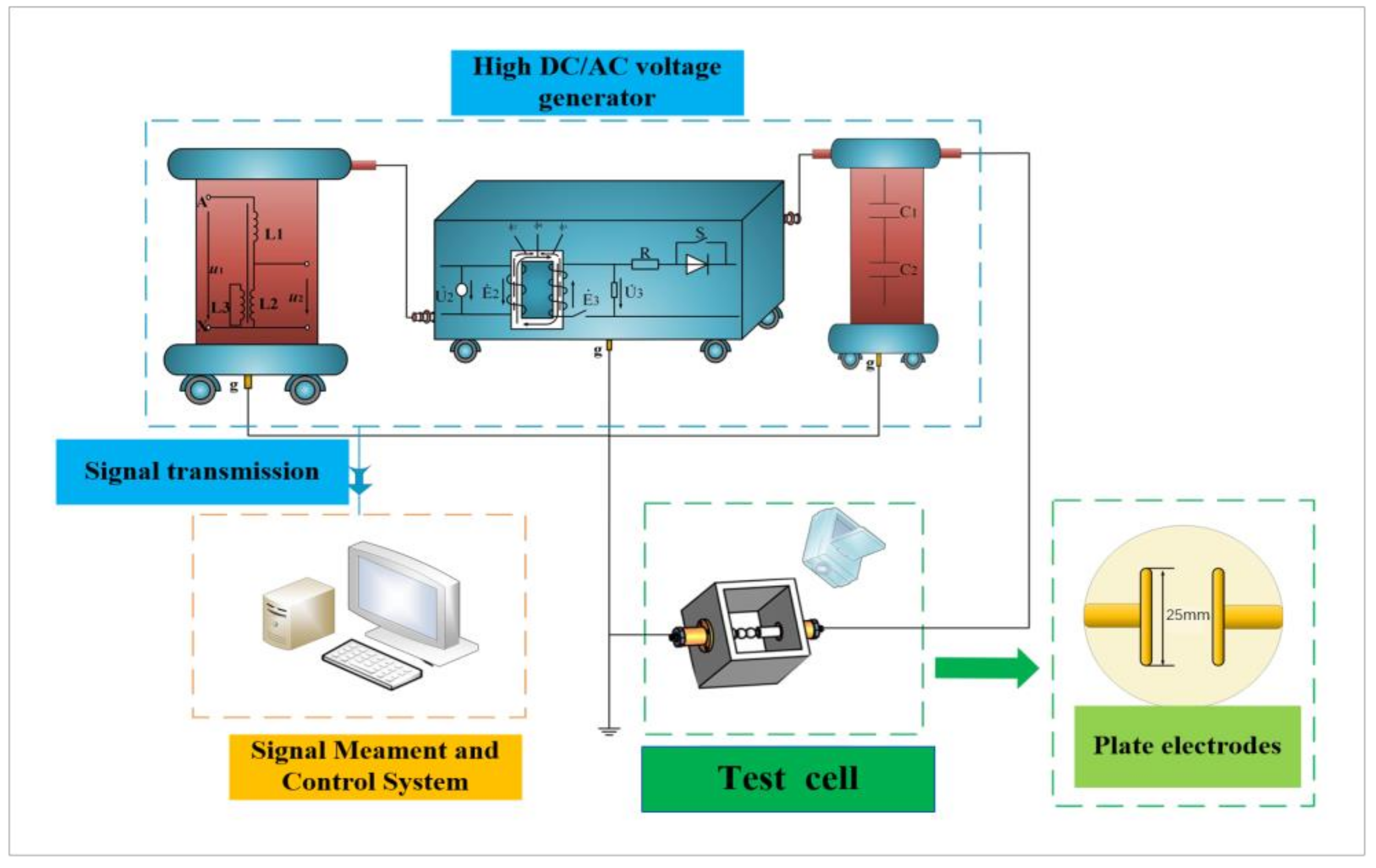
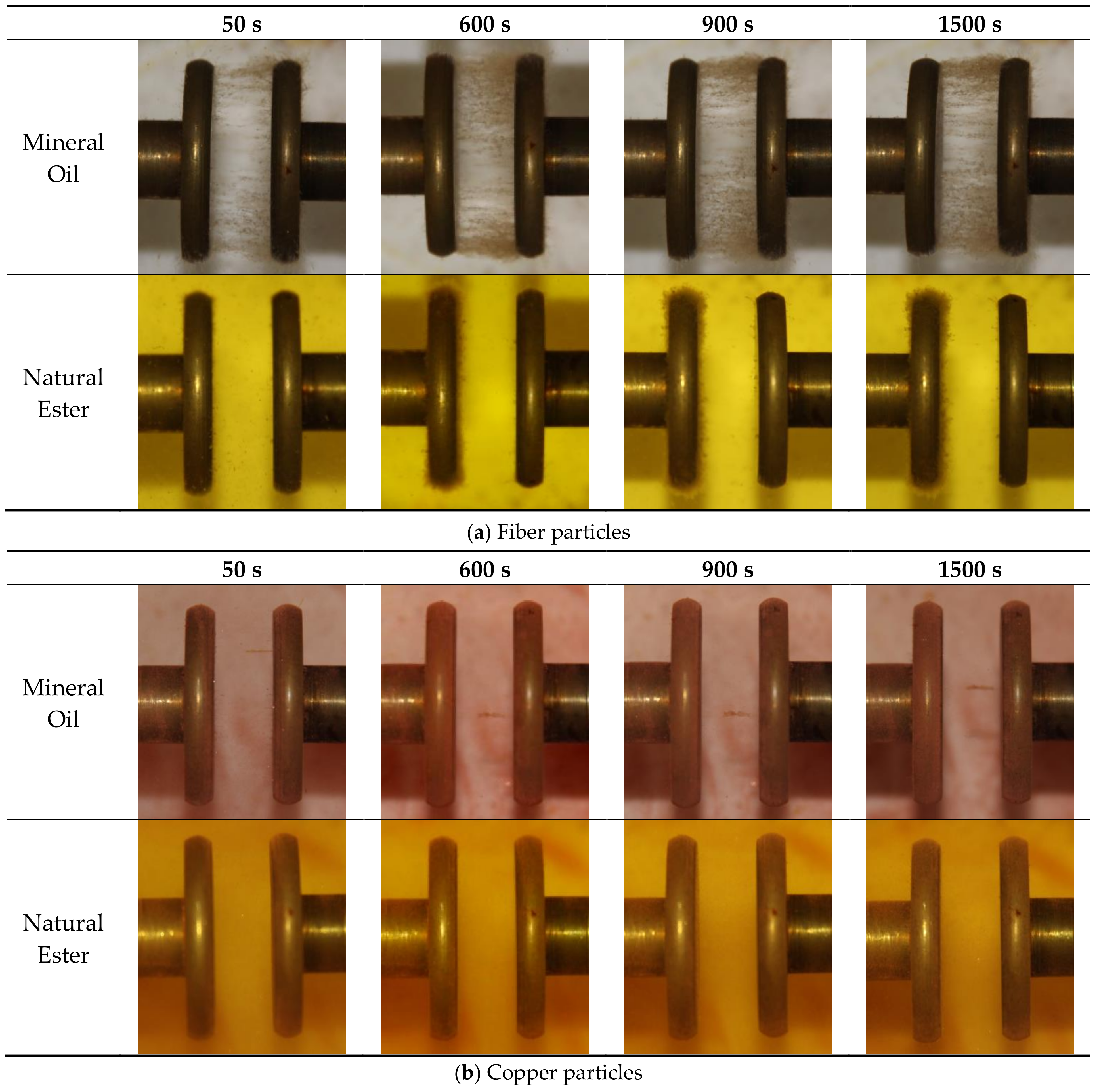
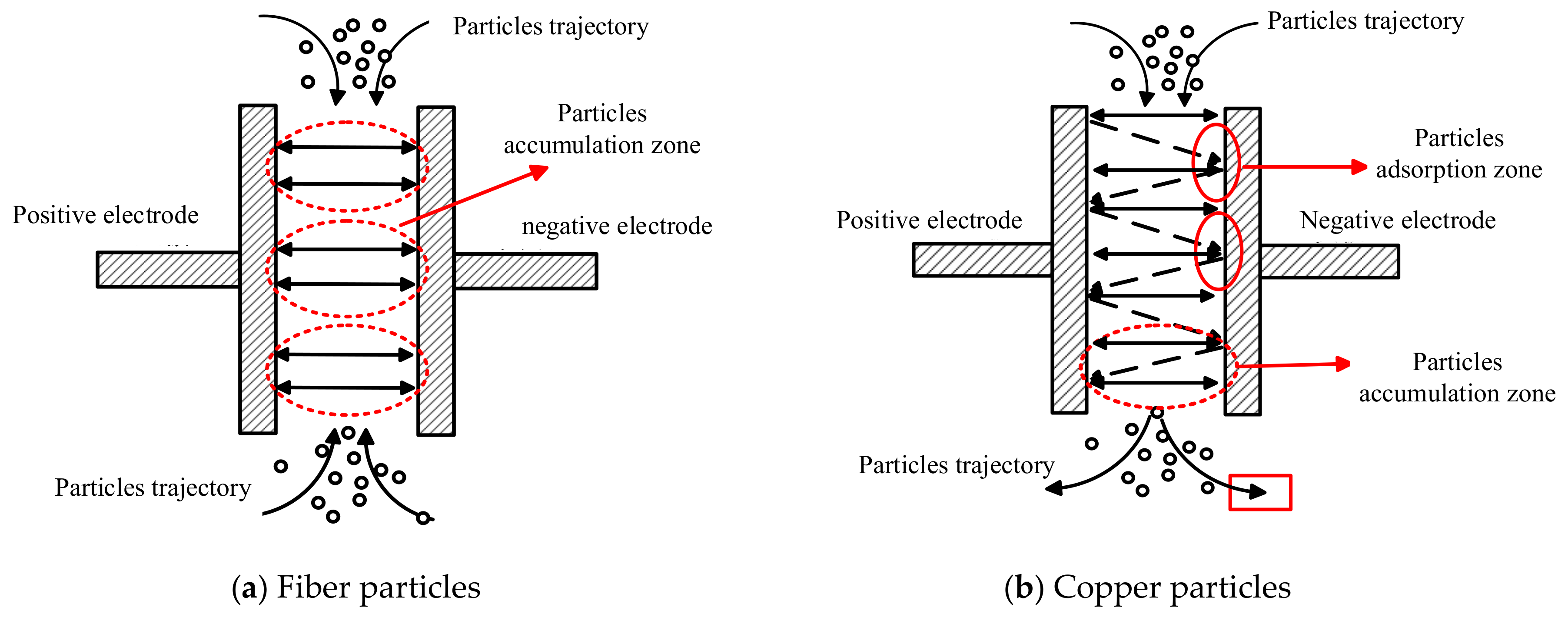


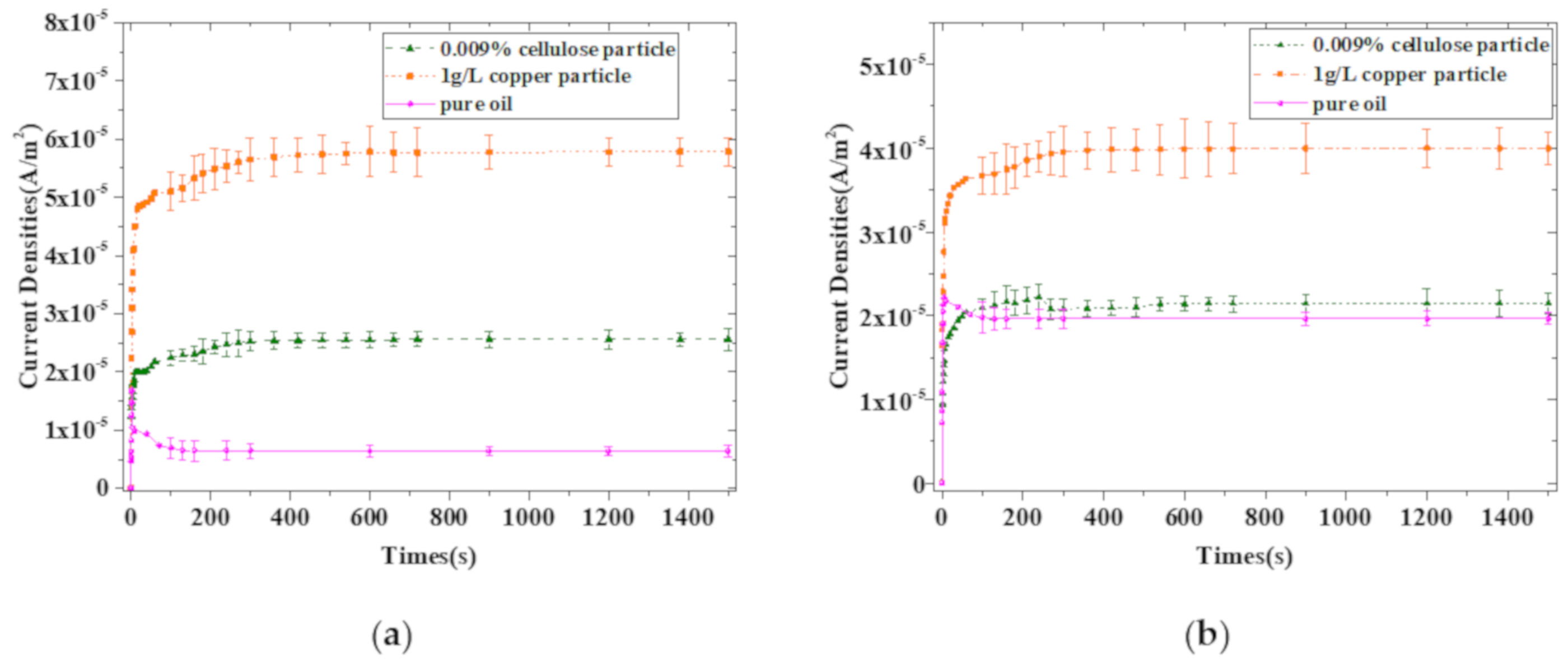
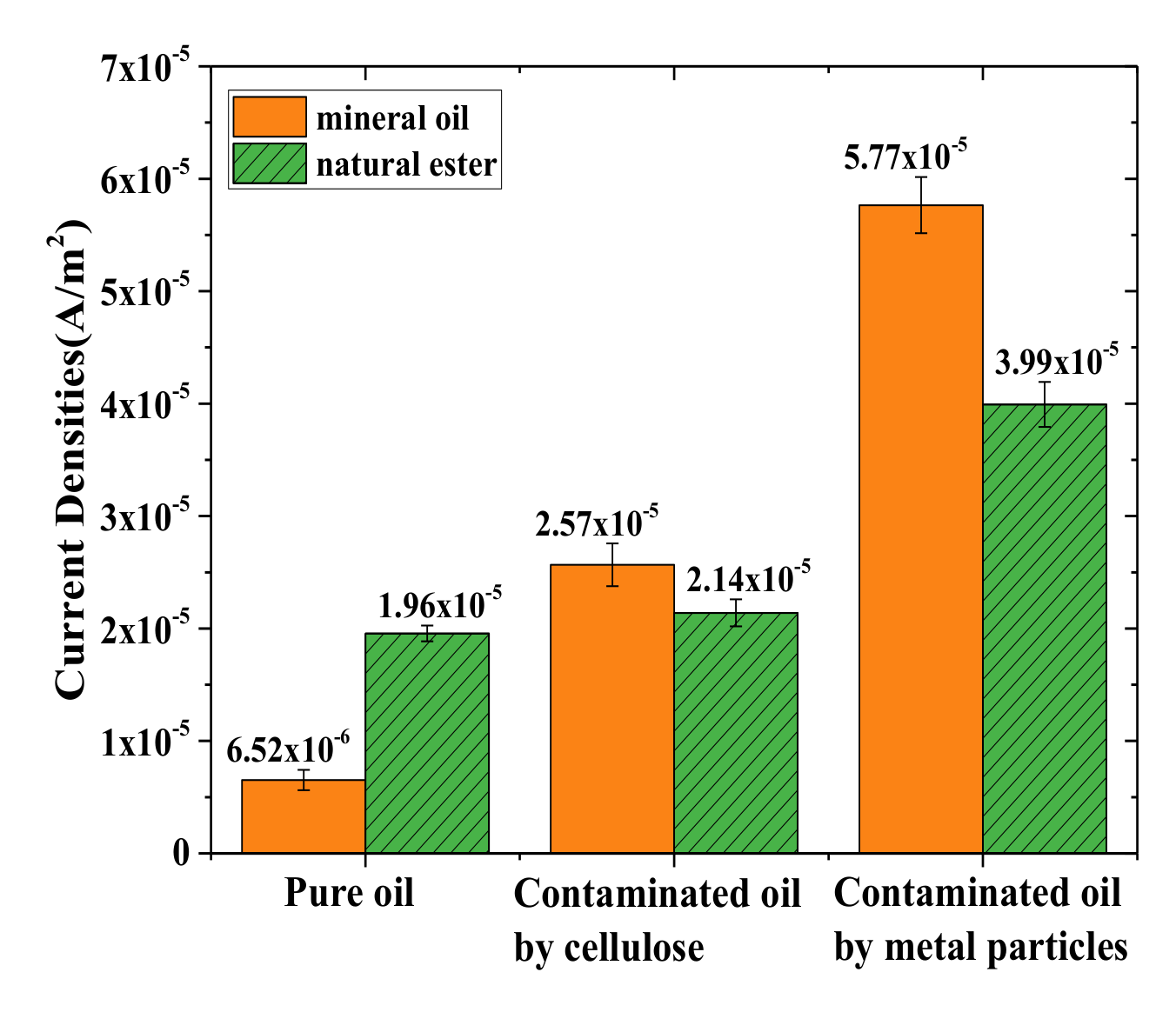



| Parameters | Mineral Oil | Natural Ester |
|---|---|---|
| Density/g/cm3 (20 ℃) | 0.89 | 0.91 |
| Viscosity/mm2/s (20 ℃) | 25.70 | 78.50 |
| Relative permittivity (20 ℃, 50 Hz) | 2.2 | 3.1 |
| Volume resistivity/Ω·m (20 ℃) | 4.68×1013 | 3.327×1010 |
| Moisture content/ppm | 9 | 41 |
| Acidity/mgKOH/g | 0.0056 | 0.01245 |
| Tan (90 ℃, %) | 0.0536 | 0.5085 |
| AC Breakdown voltage/kV (2.5 mm) | 65 | 78 |
| Particle Type | Particles Concentration | ||||
|---|---|---|---|---|---|
| Fiber particles | 0.001% | 0.003% | 0.006% | 0.009% | 0.012% |
| Copper particles | 0.1 g/L | 0.3 g/L | 0.6 g/L | 1 g/L | 1.5 g/L |
| Fiber Particle Concentration (%) | Pure Oil | 0.001 | 0.003 | 0.006 | 0.009 | 0.012 |
| α (kV) | 76.6 | 67.6 | 65.6 | 63.0 | 61.7 | 59.4 |
| β | 26.5 | 25.0 | 35.9 | 39.1 | 35.3 | 30.7 |
| 50% probability failure (kV) | 75.6 | 66.6 | 64.9 | 62.5 | 61.1 | 58.6 |
| 5% probability failure (kV) | 68.4 | 60.0 | 60.4 | 58.4 | 56.7 | 53.8 |
| Copper Particle Concentration (g/L) | Pure Oil | 0.1 | 0.3 | 0.6 | 1 | 1.5 |
| α (kV) | 76.6 | 59.2 | 56.9 | 53.4 | 51.9 | 42.4 |
| β | 26.5 | 13.5 | 16.5 | 27.2 | 21.6 | 19.9 |
| 50% probability failure (kV) | 75.6 | 57.6 | 55.6 | 52.7 | 51.0 | 41.6 |
| 5% probability failure (kV) | 68.4 | 47.5 | 47.5 | 47.9 | 45.2 | 36.5 |
| Fiber Particle Concentration (%) | Pure Oil | 0.001 | 0.003 | 0.006 | 0.009 | 0.012 |
| α (kV) | 78.6 | 71.5 | 70.1 | 68.8 | 64.8 | 62.7 |
| β | 31.1 | 45.4 | 19.7 | 18.0 | 37.5 | 23.8 |
| 50% probability failure (kV) | 77.7 | 70.9 | 68.8 | 67.4 | 64.2 | 61.8 |
| 5% probability failure (kV) | 73.1 | 68.0 | 62.5 | 60.7 | 61.0 | 55.3 |
| Copper Particle Concentration (g/L) | Pure Oil | 0.1 | 0.3 | 0.6 | 1 | 1.5 |
| α (kV) | 78.6 | 66.8 | 64.4 | 61.0 | 58.8 | 46.3 |
| β | 31.1 | 28.2 | 27.9 | 39.4 | 25.7 | 19.5 |
| 50% probability failure (kV) | 77.7 | 65.9 | 63.6 | 60.4 | 57.9 | 45.4 |
| 5% probability failure (kV) | 71.5 | 60.1 | 57.9 | 56.5 | 52.3 | 39.7 |
© 2020 by the authors. Licensee MDPI, Basel, Switzerland. This article is an open access article distributed under the terms and conditions of the Creative Commons Attribution (CC BY) license (http://creativecommons.org/licenses/by/4.0/).
Share and Cite
Cheng, L.; Jiang, Y.; Dan, M.; Wen, H.; Li, Y.; Qin, W.; Hao, J. Effects of Fiber and Copper Particles on Conductivity and Breakdown Characteristics of Natural Ester and Mineral Oil under DC Voltage. Energies 2020, 13, 1818. https://doi.org/10.3390/en13071818
Cheng L, Jiang Y, Dan M, Wen H, Li Y, Qin W, Hao J. Effects of Fiber and Copper Particles on Conductivity and Breakdown Characteristics of Natural Ester and Mineral Oil under DC Voltage. Energies. 2020; 13(7):1818. https://doi.org/10.3390/en13071818
Chicago/Turabian StyleCheng, Lin, Yi Jiang, Min Dan, Hao Wen, Yanqing Li, Wei Qin, and Jian Hao. 2020. "Effects of Fiber and Copper Particles on Conductivity and Breakdown Characteristics of Natural Ester and Mineral Oil under DC Voltage" Energies 13, no. 7: 1818. https://doi.org/10.3390/en13071818





